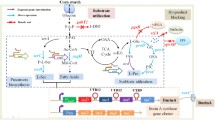Abstract
Whole cells of Escherichia coli overexpressing a glucosyltransferase from Vitis vinifera were used for the glucosylation of geraniol to geranyl glucoside. A high cell density cultivation process for the production of whole-cell biocatalysts was developed, gaining a dry cell mass concentration of up to 67.6 ± 1.2 g L−1 and a glucosyltransferase concentration of up to 2.7 ± 0.1 g protein L−1 within a process time of 48 h. Whole-cell batch biotransformations in milliliter-scale stirred-tank bioreactors showed highest conversion of geraniol at pH 7.0 although the pH optimum of the purified glucosyltransferase was at pH 8.5. The biocatalytic batch process performance was improved significantly by the addition of a water-immiscible ionic liquid (N-hexylpyridinium bis(trifluoromethylsulfonyl)imid) for in situ substrate supply. The so far highest final geranyl glucoside concentration (291 ± 9 mg L−1) and conversion (71 ± 2 %) reported for whole-cell biotransformations of geraniol were achieved with 5 % (v/v) of the ionic liquid.



Similar content being viewed by others
References
Rastogi SC, Heydorn S, Johansen JD et al (2001) Fragrance chemicals in domestic and occupational products. Contact Dermat 45:221–225
Herrmann A (2007) Controlled release of volatiles under mild reaction conditions: from nature to everyday products. Angew Chem Int Ed 46:5836–5863
Bönisch F, Frotscher J, Stanitzek S et al (2014) Activity-based profiling of a physiologic aglycone library reveals sugar acceptor promiscuity of family 1 UDP-Glucosyltransferases from grape. Plant Physiol 166:23–39
Caputi L, Lim E, Bowles D (2008) Discovery of New Biocatalysts for the Glycosylation of Terpenoid Scaffolds. Chem Eur J 14:6656–6662
Duetz WA, van Beilen JB, Witholt B (2001) Using proteins in their natural environment: potential and limitations of microbial whole-cell hydroxylations in applied biocatalysis. Curr Opin Biotechnol 12:419–425
Bräutigam S, Bringer-Meyer S, Weuster-Botz D (2007) Asymmetric whole cell biotransformations in biphasic ionic liquid/water-systems by use of recombinant Escherichia coli with intracellular cofactor regeneration. Tetrahedron Asymmetry 18:1883–1887
Pfruender H, Jones R, Weuster-Botz D (2006) Water immiscible ionic liquids as solvents for whole cell biocatalysis. J Biotechnol 124:182–190
León R, Fernandes P, Pinheiro HM et al (1998) Whole-cell biocatalysis in organic media. Enzyme Microb Technol 23:483–500
Cull SG, Holbrey JD, Vargas-Mora V et al (2000) Room-Temperature Ionic Liquids as Replacements for Organic Solvents in Multiphase Bioprocess Operations. Biotechnol Bioeng 69:227–233
Freemantle M (1998) Designer solvents—Ionic liquids may boost clean technology development. Chem Eng News 76:32–37
Pfruender H, Amidjojo M, Kragl U et al (2004) Efficient whole-cell biotransformation in a biphasic ionic liquid/water system. Angew Chem Int Ed 43:4529–4531
Weuster-Botz D (2007) Process intensification of whole-cell biocatalysis with ionic liquids. Chem Record 7:334–340
Puskeiler R, Kaufmann K, Weuster-Botz D (2005) Development, parallelization, and automation of a gas-inducing milliliter-scale bioreactor for high-throughput bioprocess design (HTBD). Biotechnol Bioeng 89:512–523
Dennewald D, Hortsch R, Weuster-Botz D (2012) Evaluation of parallel milliliter-scale stirred-tank bioreactors for the study of biphasic whole-cell biocatalysis with ionic liquids. J Biotechnol 157:253–257
Carmichael AJ, Seddon KR (2000) Polarity study of some 1-alkyl-3-methylimidazolium ambient-temperature ionic liquids with the solvatochromic dye. Nile Red J Phys Org Chem 13(10):591–595
Thuy Pham TP, Cho C, Yun Y (2010) Environmental fate and toxicity of ionic liquids: a review. Water Res 44(2):352–372
Docherty KM, Dixon JK, Kulpa CF Jr (2007) Biodegradability of imidazolium and pyridinium ionic liquids by an activated sludge microbial community. Biodegradation 18(4):481–493
Riesenberg D, Schulz V, Knorre WA et al (1991) High cell density cultivation of Escherichia coli at controlled specific growth rate. J Biotechnol 20:17–28
Fairbanks G, Steck TL, Wallachl DFH (1971) Electrophoretic analysis of the major polypeptides of the human erythrocyte membrane. Biochemistry 10:2606–2617
Lee SY (1996) High cell-density culture of Escherichia coli. Review. Trends Biotechnol 14:98–105
Schott C (2008) Proactive Debottlenecking: planing Ahead for the Downstream Bottleneck. BioProcess Int 6:18–23
de Roode BM, Franssen MCR, van der Padt A et al (2003) Perspectives for the Industrial Enzymatic Production of Glycosides. Review. Biotechnol Prog 19:1391–1402
Gunata YZ, Bayonove CL, Baumes RL et al (1985) The aroma of grapes I. Extraction and determination of free and glycosidically bound fractions of some grape aroma components. J Chromatogr A 331:83–90
Acknowledgments
The authors gratefully acknowledge the support of Andreas Schmideder by the TUM Graduate School (Technische Universität München, Germany). The support of Xenia Priebe by the International Graduate School of Science and Engineering (Technische Universität München, Germany) is acknowledged as well. We are thankful for the support of Fong-Chin Huang by the FLÜGGE program.
Author information
Authors and Affiliations
Corresponding author
Rights and permissions
About this article
Cite this article
Schmideder, A., Priebe, X., Rubenbauer, M. et al. Non-water miscible ionic liquid improves biocatalytic production of geranyl glucoside with Escherichia coli overexpressing a glucosyltransferase. Bioprocess Biosyst Eng 39, 1409–1414 (2016). https://doi.org/10.1007/s00449-016-1617-6
Received:
Accepted:
Published:
Issue Date:
DOI: https://doi.org/10.1007/s00449-016-1617-6




